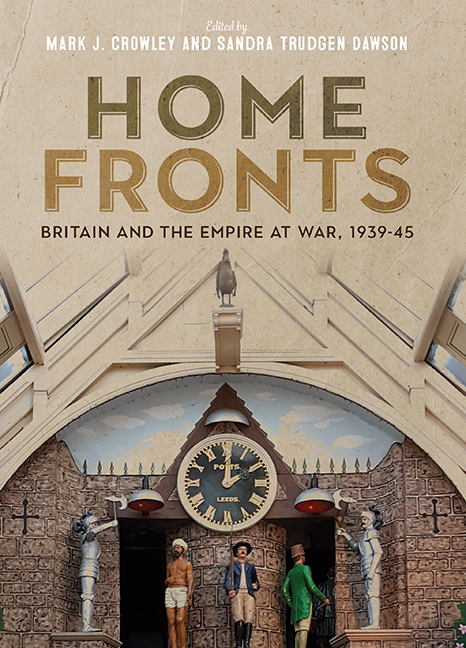Book contents
- Frontmatter
- Dedication
- Contents
- List of Illustrations
- List of Contributors
- Acknowledgements
- List of Abbreviations
- Introduction: Home Fronts and the Empire at War
- Part One Consumption on the Home Front
- Part Two The Militarized Home Front
- 5 ‘Young blood’ and ‘the blackout’: Love, Sex and Marriage on the South African Home Front
- 6 Ceylon's Home Front during the Second World War
- 7 Nyanza at War: Kenya and the Mobilization of Britain's Colonial Empire
- 8 ‘Fighting In Their Ways’? The Civilian Man in British Culture, 1939–1945
- Part Three Technology, Danger and Waste on the Home Front
- Select Bibliography
- Index
5 - ‘Young blood’ and ‘the blackout’: Love, Sex and Marriage on the South African Home Front
from Part Two - The Militarized Home Front
Published online by Cambridge University Press: 30 August 2017
- Frontmatter
- Dedication
- Contents
- List of Illustrations
- List of Contributors
- Acknowledgements
- List of Abbreviations
- Introduction: Home Fronts and the Empire at War
- Part One Consumption on the Home Front
- Part Two The Militarized Home Front
- 5 ‘Young blood’ and ‘the blackout’: Love, Sex and Marriage on the South African Home Front
- 6 Ceylon's Home Front during the Second World War
- 7 Nyanza at War: Kenya and the Mobilization of Britain's Colonial Empire
- 8 ‘Fighting In Their Ways’? The Civilian Man in British Culture, 1939–1945
- Part Three Technology, Danger and Waste on the Home Front
- Select Bibliography
- Index
Summary
REFLECTING on her experience hosting Allied troops in Cape Town during the war, Lucy Bean described a whirlwind of social activities and romance:
The girls in Cape Town had a wonderful time. Just imagine sixty thousand men in town at any one time. They were very much in demand, I can tell you. There were lots of high jinks, lots of fun and quite a lot of engagements.
Bean was one of the founders of the South African Women's Auxiliary Service (SAWAS), which organised more than 60,000 volunteers to host visiting Allied troops. Her account captures the heightened atmosphere of wartime Cape Town and its often-overlooked strategic role in the Allied war effort. Like many other Anglo-South Africans, however, Bean's reminiscence of this time before the isolations of apartheid is nostalgic, glossing over the social conflicts caused by the arrival of so many Allied troops during the war.
Though often seen as peripheral to the war effort, the Union of South Africa became a transportation hub, a centre for military training and the staging ground for the invasion of Vichy-held Madagascar. The war brought millions of Allied servicemen to South Africa, along with thousands of refugees, prisoners-of-war and civilians. With the Mediterranean route largely closed to the Allies owing to the threat of the Italian fleet, German U-boats and land-based Axis bombers, the port cities of South Africa saw a tremendous increase in shipping for three years from 1940 until the invasion of Italy in 1943. More than 400 troop convoys carrying six million Allied servicemen en route to destinations including North Africa, India and the Pacific and close to 50,000 Allied ships passed through South Africa during the war. South African ports also served as repair stations for Allied ships, especially after the loss of Singapore, repairing more than 13,000 vessels.
- Type
- Chapter
- Information
- Home Fronts - Britain and the Empire at War, 1939–45 , pp. 93 - 110Publisher: Boydell & BrewerPrint publication year: 2017

